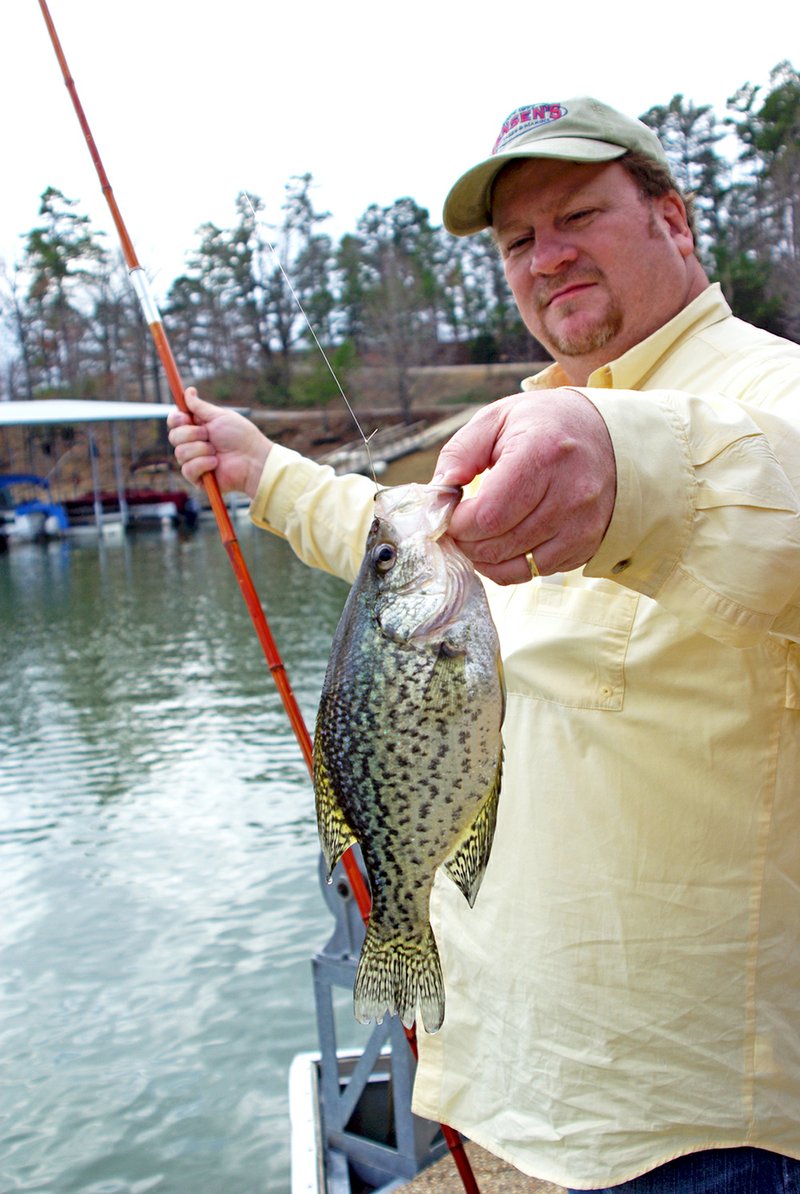On a recent trip to Lake Greeson near Kirby, three friends and I caught crappie after crappie after crappie. All the 50 fish we boated weighed more than a pound each, and about a third weighed between 2 and 3 pounds. That’s a nice mess of crappie.
Fact is, many Arkansas lakes produce excellent crappie fishing like this, even during the hot summer months. Greeson ranks among the best for trophy-size crappie, but scores of Natural State waters produce loads of 1- to 2-pounders for savvy anglers. And it seems those big “barn doors” — crappie weighing 2 pounds or more — are becoming more common in waters statewide, including some of the lakes described in the following paragraphs, destinations where you should find hot action throughout the rest of this year.
To start, here’s some basic information to increase your success.
When crappie are deep, as they tend to be when the weather is hot, ultralight spinning or spincast combos spooled with 4- to 10-pound line are appropriate. This combination lets you get down where the fish are and allows pinpoint casts to open cover.
You also can fish with long (10- to 16-foot) jigging poles or cane poles. Pole fishing permits you to fish brushpiles, treetops and other dense cover with fewer hang-ups. The trusty ol’ cane pole is simple, inexpensive and efficient. But today’s anglers typically use higher-quality fiberglass or graphite poles with built-in line holders, allowing line length to be easily adjusted.
Arkansas anglers use two primary enticements when crappie fishing: minnows and jigs.
For minnow fishing, all you need is a No. 1 to 1/0 Aberdeen hook, a split shot to sink the bait and a small float that signals when a crappie bites. Live minnows can be purchased at most Arkansas bait shops.
Jigs are the most popular crappie-catching artificial lures. To be prepared for any situation, carry several styles, colors and weights. I like 1/64- to 1/16-ounce jigs, particularly marabou models with feather tails, or tube jigs with soft-plastic skirts that are interchangeable.
I also keep a variety of small safety-pin spinners in my tackle box. These can be snapped on a jig to add extra crappie-attracting flashiness and vibration in stained or muddy water. In addition, I carry a small selection of other crappie-catching lures to use in situations where jig fishing isn’t productive. My favorites are 1/8- to 1/4-ounce spoons, mini-crankbaits that imitate baitfish, and Road Runner spinners.
Regardless of where you fish, you must establish a fishing pattern to be successful. What cover are crappie using? At what depth? Are they hitting best early or late? On minnows or jigs? Yellow jigs or blue? Vary your tactics until you determine what’s best.
Deep-holding summer crappie can be hard to locate, but when you do, you’re likely to catch a dozen or more in each spot. Fish deep cover located with sonar, or troll with several lines at different depths until you find fish.
With the right equipment, an in-depth knowledge of the crappie’s predictable habits and a little luck, you can hit the jackpot almost any place and time you fish. But the following waters are better than most.
Northeast Arkansas
Drop a minnow or jig in just about any body of water in this region, and you can expect a crappie to nab it. Arkansas Game and Fish Commission lakes such as Charles, Ashbaugh, Poinsett and Hogue are great hot spots, as are the Mississippi oxbow lakes near West Memphis, including Dacus, Island 40 Chute and Horseshoe, and small state park lakes such as Walcott, Austell and Dunn.
Southeast Arkansas
This region has been lovingly referred to as “The Land of the Barn-Door Crappie.” Quality crappie lakes are numerous here, including such well-known waters as Lake Chicot, Paradise, Belcoe, Grand, Grampus, Wilson Brake, Felsenthal and Enterprise. My three favorite lakes here are Midway, Whitehall and Old Town, all oxbows of the Mississippi River.
Southwest Arkansas
My top pick in this region is Lake Greeson, a U.S. Army Corps of Engineers impoundment west of Hot Springs. Most natural cover here has rotted away, and the best fishing is around the hundreds of bamboo fish attractors placed in the lake. It’s usually not hard to catch a limit of slabs any season if you target attractors in depths where sonar
indicates crappie schools. The fish are suckers for jigs,
minnows or jig/minnow combos, and chances are excellent you could catch the crappie of a lifetime. Other top-notch crappie lakes in this region include lakes Hamilton, Catherine and Ouachita near Hot Springs, DeGray Lake near Arkadelphia, Millwood Lake near Ashdown and White Oak Lake near Camden.
Northwest Arkansas
Dozens of smaller lakes here serve up fast-paced crappie
fishing for in-the-know anglers, including Fayetteville, Sequoyah, Elmdale and Bob Kidd. For the best crappie fishing, however, get out on big waters, specifically the Corps of Engineers
impoundments in this region such as Beaver, Bull Shoals and Norfork lakes. Also good in summer are backwaters of the upper White River, where crappie go to enjoy the cooler water temperatures.
Central Arkansas
Maumelle, Overcup, Willow Beach, Dardanelle, Conway, Pickthorne — these are just a few of the many superb crappie lakes in Arkansas’ midsection. Lakes Nimrod and Conway are also here, and among Arkansas crappie fans, both reservoirs are legendary. These two cover-laden bodies of water produce huge stringers of barn-door crappie, fish that commonly weigh 1 1/2 to 3 pounds.
